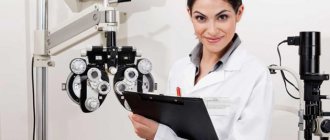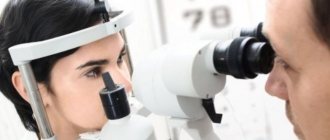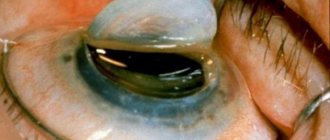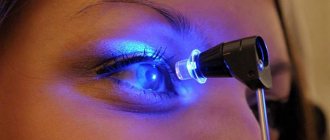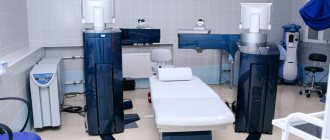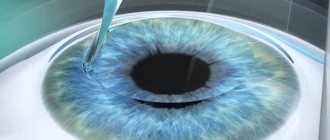Lasik or femto lasik?
Lasik and femto lasik are modern vision correction techniques that impact the corneal flap, thereby changing its shape and correcting it, which helps improve the clarity of the patient’s vision.
What do the operations have in common?
The methods work on the same principle: a targeted effect on the intermediate area of the cornea, polishing it and, as a result, improving vision. After surgery, as a rule, there is no deterioration in vision, or it is insignificant.
ATTENTION! With these surgeries, it is possible to correct vision in both eyes in one procedure. The techniques correct astigmatism, myopia and farsightedness.
Differences
- With the Lasik technique, the operation is performed using a medical instrument - a microkerat. It is used to separate the required layer of epithelium, and then use laser beams to influence its shape.
- With the femtolasik (knifeless) technique, only lasers are used, two types:
- Femtosecond is a high-precision device that creates the thinnest corneal layer of the required thickness;
- Excimer laser is a laser that resurfaces the surface of the cornea and changes the radius of its curvature.
Price difference
Lasik: If we take the price for both eyes with myopia up to -4 d, then it will be equal to 60 thousand rubles.
Femto Lasik: For the same myopia, the price will be 110 thousand rubles for both eyes.
IMPORTANT! For higher myopia or astigmatism, the cost of the procedure will be approximately 20% higher.
My experience in laser vision correction (Femto Lasik, Moscow)
Hi all!
I decided to share here my experience of laser vision correction. When I decided to have surgery, I probably searched the entire RuNet on this topic, and found a lot of information on the BB. I think it would be fair to tell about everything now, in case it comes in handy for someone)
When I decided to have surgery, I probably searched the entire RuNet on this topic, and found a lot of information on the BB. I think it would be fair to tell about everything now, in case it comes in handy for someone)
I’ll start with the fact that it took me several years to gather my courage - I’m scared just like everyone else, after all, my eyes. My eyesight has been poor since childhood, caused by reading (including at night) and genetics. At least this is how I explain it to myself. At the time of the examinations and surgery, I had -5 myopia in both eyes, with slight astigmatism. Vision is stable, fixed at this level for 20 years and has not fallen below. I have been wearing soft contact lenses for 10 years, and nighttime (orthokeratological) lenses for the last two years. But my eyes are so tired from this endless many years of picking at them, there are no words.
When it was time to change my night lenses again (replacement once a year), I thought it was time to take a more thorough approach to the issue of vision correction, and began to look for a clinic and collect recommendations. Based on the recommendations of former colleagues and acquaintances who had already done LKZ, I chose the Novy Vzglyad and Gazprom clinics. Both were undergoing diagnostics.
Initially I leaned towards the New Look
, largely because it's five minutes from my house. In addition, I was captivated by so many celebrity clients (there is a whole section on their website, and there are photos posted in the hallway of the clinic) who trusted them with their eyes. Their price tag for surgery is average in Moscow, plus or minus the same as in other similar clinics. The diagnostics are a bit expensive - 5400. Based on the diagnostic results, there were no contraindications, and I was offered to do REIC - this is their patented technology, but they could not clearly explain to me how it fundamentally differs from regular LASIK. The surgical technology for both of these methods is the same - the corneal flap is cut with a microkeratome, the cornea is evaporated with an excimer laser, and the flap is put back.
As I collected information on the Internet and recommendations, it turned out that there is a new LZK method - FEMTO LASIK. The most advanced, sophisticated and expensive vision correction surgery. This is when the cornea is not cut off, but under the action of a femtosecond laser it is stratified, so the operation is non-contact, completely safe, after which rehabilitation is easier and faster. Well, plus it is suitable for those who have a strong minus or thin cornea, when regular lasik (or super lasik) can no longer be done. There is a lot of information about this on the Internet, read it.
You know, everything seemed to be fine in this clinic as a whole, in my opinion, but the feeling of the “everything on the knee” process did not go away until the end of the diagnosis: the initial examination, instillation of drops takes place in some archive room, waiting in a dull corridor on chairs, etc. - too modest for a pretentious clinic, as they position themselves, mmk.
Plus, in New Look they don’t do FEMTO, and since I was set on this particular method, it was decided to refuse this clinic.
Polyclinic OJSC Gazprom
— I ended up having my surgery done with them. Among the inconveniences: to enter the clinic, you need to go through a checkpoint (standing in line in the morning at the pass issuing point in bad weather is a dubious pleasure) and they do not accept cards for payment (it is not very comfortable to carry a considerable amount of money to pay for the operation in cash). Otherwise, the clinic made an extremely favorable impression: polite staff, efficiency in resolving all issues, advanced equipment, experience and reputation of the surgeon - everything inspired confidence and calm.
The diagnostic results allowed us to do SUPER LASIK or FEMTO LASIK, all that remained was to choose (save money))). As I already wrote, I did FEMTO.
There is no need to be afraid of the operation itself - it is absolutely painless. You come, they give you a pill (I thought it was a sedative, but no - ketans), then they take you to the preoperative room, where they put on a gown, cap and shoe covers over your clothes, treat almost your entire face with an alcohol solution and instill copious amounts of pain-relieving drops. The operation, according to my feelings, lasted 5 minutes for both eyes: the femtosecond laser works for 15 seconds, then the doctor removes the formed flap, then the excimer laser works for another 40 seconds, which burns the cornea, and then the flap is returned to its place, filled with drops, and the same thing is done with the second eye. I repeat once again, it doesn’t hurt at all. The only thing is that the femtosecond laser is pressed very tightly to the eye, as if they are pulling it over the eye. It's a little unpleasant, but not painful and doesn't last long. I didn’t feel the eyelid expander, which many people write about, at all; it didn’t cause me any discomfort.
Immediately after the operation I could see well, although a little in a fog. About 10 minutes after the operation the most interesting thing begins))) I don’t want to scare anyone, everyone experiences recovery differently, but for me it lasted almost 6 hours: photophobia (and sunglasses didn’t help much), tears flowed like a river so that It was impossible to open my eyes, and there was a sensation of sand in my eyes. At the same time, it is recommended to blink more often after the operation, but I was not very good at this task. After about 40 minutes, my eyes were checked and I was sent home until tomorrow. The anesthetic dropped during the check lasted about 15 minutes - just enough to pay, call a taxi and go downstairs. That’s it, it hit me again, in the taxi I apparently looked very pitiful - the taxi driver was lamenting all the way that he couldn’t help me in any way))) I got home almost by touch. Moral - take an accompanying person with you, don’t play at being an adult, self-sufficient girl like me)) At home I tried to sleep, it didn’t work, and I just waited for him to let go, periodically went to the bathroom to blink - only there in absolute darkness could I open my eyes)) Gradually everything passed and, oh happiness, I was able to fully enjoy my new vision for the first time. This is a real delight and magic, of course. Looking ahead, I’ll say that in the end I have 150% in both eyes, isn’t that wonderful?!
About 10 minutes after the operation the most interesting thing begins))) I don’t want to scare anyone, everyone experiences recovery differently, but for me it lasted almost 6 hours: photophobia (and sunglasses didn’t help much), tears flowed like a river so that It was impossible to open my eyes, and there was a sensation of sand in my eyes. At the same time, it is recommended to blink more often after the operation, but I was not very good at this task. After about 40 minutes, my eyes were checked and I was sent home until tomorrow. The anesthetic dropped during the check lasted about 15 minutes - just enough to pay, call a taxi and go downstairs. That’s it, it hit me again, in the taxi I apparently looked very pitiful - the taxi driver was lamenting all the way that he couldn’t help me in any way))) I got home almost by touch. Moral - take an accompanying person with you, don’t play at being an adult, self-sufficient girl like me)) At home I tried to sleep, it didn’t work, and I just waited for him to let go, periodically went to the bathroom to blink - only there in absolute darkness could I open my eyes)) Gradually everything passed and, oh happiness, I was able to fully enjoy my new vision for the first time. This is a real delight and magic, of course. Looking ahead, I’ll say that in the end I have 150% in both eyes, isn’t that wonderful?!
The feeling of speck in one eye went away on the fifth day after the operation (the second felt great right away), and the eyes tired quickly, and these are all the post-operative effects that I had, and this is nothing compared to the excellent vision.
Like everyone who decided to have this operation, I regret only one thing - that I did not do it earlier.
This is where my many letters end . I’m glad if my experience is useful to someone. If you have any questions, write!
. I’m glad if my experience is useful to someone. If you have any questions, write!
LASIK surgery
The technique consists of the synthesized effect of a surgical instrument and laser on the cornea. The ophthalmologist cuts off a piece of corneal tissue and gently bends it back using a microkerat. Afterwards, the doctor burns out some areas of the incision with a laser, thus creating a new shape of the epithelial surface. The cornea of the eye is renewed and improved vision is formed.
Advantages
- The operation can be performed on both eyes;
- All procedures and the healing process take place within 24 hours;
- The surgeon uses local anesthesia in the form of eye drops that do not cause allergies or discomfort;
- The work takes place in the middle layer of the cornea, so the surface layer of the ocular epithelium is not damaged;
- No surgical sutures are required after the operation;
- The risk of any complications is minimal.
Progress of the operation
The femto super-LASIK operation is carried out in several stages:
- At the preliminary stage, the patient is instilled with pain-relieving drops. After this, he looks ahead for several seconds while, using the VisuMax femtosecond laser, the surgeon models the corneal flap on the surface of the eye, taking into account all the features of the visual system of a particular patient.
- The second stage is the application of a refractive profile, which is performed using the SCHWIND Amaris excimer laser. The surgeon performs this manipulation very quickly - no longer than 10 seconds, because it is already pre-programmed for a specific person. At the same time, the doctor indicates to the patient the direction where he needs to move his gaze. Pain and discomfort are completely absent at this stage.
- The third stage is the completion of the operation with the disposition of the simulated valve. After some time, a control examination by the surgeon takes place and the patient can leave the clinic. The next day, the patient makes a scheduled visit to the ophthalmologist and can begin work and return to his normal lifestyle without any visual restrictions.
Modernized techniques based on LASIK
Laser vision correction using the Lasik technique, or laser keratomileusis, was first performed in 1989.
There are modernized techniques based on this technology:
- Femtolasic;
- Super-lasik - personalized support for laser vision correction;
- Photorefractive keratectomy (PRK);
- Laser epithelial keratomileusis (Lasek).
Useful video
Laser vision correction SUPER LASIK:
Operations femtolasik and femto super lasik
Femtolasik is a more innovative surgical technique for vision correction. Here, the cornea is cut using a laser rather than a surgical instrument. Otherwise, the steps are the same as with Lasik - part of the cornea is cut off and folded back. The patient has no pain at all.
Femto super lasik is the most modern and more advanced laser vision correction technology; it is used for severe myopia, farsightedness and astigmatism. A more modern laser is used; its beam is able to accurately replicate the contours of the cornea and anatomical curvature, which guarantees results.
IMPORTANT! Femto Super Lasik is absolutely safe for the patient; All the work is performed by a system with a laser, while the surgeon carefully monitors the process. The approach is individual: before the operation, the patient's cornea is scanned with an aberrometer; it helps to determine the refractive power more accurately.
Advantages
- From start to finish, the procedure is painless;
- Unlike the Lasik technique, a smaller area of tissue is affected;
- The laser makes a thinner cut on the cornea;
- The risk of complications is minimal;
- The recovery period takes only a few hours;
- The operation is performed on both eyes on the same day.
Flaws
More modern technologies have one significant drawback: Femto Lasik surgery is very expensive even for people with average incomes.
Benefits for the patient
For an ordinary patient who does not understand how the eye works, but clearly understands its benefits, the operation has the following advantages:
- it takes a short period of time - it only takes 10-15 minutes to remove excess layers of the cornea and give it the desired shape;
- no preparation stage - no need to refuse food, monitor your medications, exercise or not exercise;
- complex effect - not only visual acuity is restored, but also sensitivity to a small amount of light;
- maximum safety - thanks to the individual matrix, the likelihood that the laser will damage some of the desired tissues is minimal;
- preservation of the cornea - thanks to the individual matrix, more corneal tissue is preserved than with standard surgery, which means that the membrane of the eye remains stronger and is more difficult to damage;
- Preserving the cornea not only leaves the eye stronger, but also allows surgery even for people with thin corneas that would otherwise be damaged.
Super LASIK is an expensive, but quick and easy operation, for which you don’t even need to go to the hospital, you just need to spend a couple of hours in the clinic.
In what cases are Lasik, superlasik and femtolasik prescribed?
Expert opinion
Danilova Elena Fedorovna
Ophthalmologist of the highest qualification category, Doctor of Medical Sciences. Has extensive experience in diagnosing and treating eye diseases in adults and children.
All operations are available to patients over 18 years of age and up to 45 years of age for nearsightedness, farsightedness and astigmatism. To decide which method is right for you, you need to consult an ophthalmologist, who will prescribe a diagnostic test. If the patient has a thin cornea, then Lasik is not suitable for him. Otherwise, everything is decided by the patient based on the cost of the procedure and the equipment acceptable to him.
Advice for those planning surgery
Before undergoing surgery, patients think about which clinic and which doctor they will be treated by. We offer you some tips:
- Find out if the ophthalmologist has additional qualifications as a microsurgeon;
- Find out in advance all the necessary information about the doctor: his name, work experience, education, specialization. Carefully study the reviews of clients who were treated by him.
- Find out everything about the equipment used for manipulations. Good clinics do not purchase cheap devices. The best are WaveLight, SchwindAmatis, Technolas Perfect Vision.
- The clinic you choose should have good reviews from doctors and patients.
Doctors' opinion
Vitaly Alexandrovich, ophthalmologist, 23 years of work experience:
More expensive methods are intended for more complex cases. If your doctor offers to perform any technique of your choice, then you should choose Lasik so as not to overpay. The more expensive SuperLasik will most likely not provide a significant increase in the quality of vision, and the even more expensive Femtolasik will not provide a significant benefit in terms of safety.
Elena Sergeevna, ophthalmologist-surgeon, 15 years of work experience:
Femtolasik eliminates the risks associated with mechanical cutting of the flap, which is important. But this can happen if the patient accidentally twitches during the Lasik procedure.
Igor Vladislavovich, ophthalmologist-surgeon, 31 years of work experience:
Each patient can choose his own correction method, if the doctor allows it. As for restoration, Femtolasik is less smooth (albeit more uniform in thickness), but this does not affect the halo effects. If you do one eye with femto and the other with mechanics, then in the first few days after femtolasik the patient will have a little more fog in the eyes, but then the difference goes away.
Patient reviews
Sergey, 33 years old, Nizhny Novgorod:
On the third day after the operation, a colleague sat at work and coded full time. I didn’t make additional corrections, I saw with both eyes, more than 1. Then everything went well for him, it turns out that the result is good. Unlike me after femtolasik, he didn’t even have red eyes or dryness.”
Ivan, 39 years old, Moscow:
Personal experience (wives) - they did it 12 years ago - one of the first experimental lasers in the then USSR. Then they made her one (it was already 10). For 12 years it fell again (a lot on the computer). They did it again 2 months ago - before the operation the wife saw only one line, after - 5 in one eye, 8 in the other. They promise that the second eye will be 8 in a couple of months, now we are waiting. Conclusion - both times it helped a lot, there is an effect. I repeat - PERSONAL EXPERIENCE - and nothing more!
Dmitry, 27 years old, Yaroslavl:
The main thing is to strictly follow the instructions after the operation and not to abuse the results obtained (do not sit at the computer for 20 hours a day, good lighting, correct mode, etc.). Now I'm just happy that I can see well. “Additional correction” had to be done on the left eye. The procedure is not pleasant, of course, but I wouldn’t go under the knife a second time if I didn’t see the point in it - I’m essentially a very practical person.
Roman Vasilievich, 43 years old. Saint Petersburg:
I can’t say anything good or anything bad. Initially, there were problems since childhood and in the end there was 0.01%, that is, -10 + astigmatism. We did it for the first time, at first the result was excellent (they promised 0.7 - 0.8, and that’s what happened the first time - this is the best thing I’ve seen in the most excellent glasses), then it dropped to -2, -2.5. I came a second time, so to speak, “under warranty.” There were a lot of people like me, about 20 people, however, as I was told, they were collected in a few months. Now, if you try not to sit at the monitor for a long time, do exercises, then your vision is 1, in circles I see 0.8-0.9 due to astigmatism. I don’t have 100% vision and never have, but I’m very pleased. There are no halos, judging by reviews from various forums, no one is immune from halos, this is the fate of about 25% of those who have had surgery. In the dark, my vision is a little blurry, but if there is light from some light bulbs, then everything is visible perfectly. I drive either during the day or at night without any problems. Yesterday I just had a medical examination (a year and a half since the repeat operation) - everything is good, the same almost 1 in letters and 0.8-0.9 in circles. There are no contraindications after the operation, I drank, went to the sauna, went to the gym, and went to the pool. If it weren't for the operation, I wouldn't have seen my license.
Contraindications to laser vision correction
Limitations to laser vision correction
Contraindications to laser vision correction include the following points.
- Under eighteen years of age. The thing is that the child’s body is still going through the formation stage. And the operation may be pointless due to a possible relapse.
- The presence of ailments in the form of glaucoma (is chronic), cataracts (clouding of the lens occurs), keratoconus (the cornea is convex and resembles a cone).
- Previous treatment for retinal detachment using surgery.
- Progressive myopia.
- Iridocyclitis.
- Any changes in the fundus.
- Dystrophy of the retina.
- Inflammatory eye diseases.
- The period of bearing a baby and breastfeeding.
- Diabetes.
- Weakening of immune function.
- The presence of unstable refraction.
- Mental disorders.
- Performing surgery on only one visual organ.
- Acute diseases such as arthritis and collagenosis.
- Alcoholism and drug addiction of a severe type.
- Dry eye syndrome.
- Incurable blindness.
But experts say that even with one of the above diseases, you should not lose hope. Every year, technologies are improving, which will make it possible to perform laser vision correction for any critical illness.
Today, laser vision correction is classified as a cosmetic procedure, as it improves the quality of life of patients and is not an emergency rescue measure.
Preparatory measures and rehabilitation period after laser vision correction
To prepare for surgery, you should first undergo a series of tests and consult with an ophthalmologist. Fourteen days before the procedure, you should stop wearing soft lenses. This is necessary so that visual function returns to its normal state. Three days before laser vision correction, you should stop drinking alcohol and using any cosmetics.
During the rehabilitation period, the doctor gives several recommendations that should be followed.
- No touching of the visual organs.
- Limit washing to three days. During this time, you should not wash your hair, take a shower, or wash your eyes and face.
- Avoiding ultraviolet rays for two weeks. During this time, you must wear sunglasses.
- Avoiding contact of the visual organs with hot and cold air.
- Ban on using cosmetics for two weeks.
- Elimination of physical activity.
- Ban on visiting saunas and swimming pools for one and a half months.
- Refusal from woolen clothes with a neckline.
- Restrictions on driving cars in the dark.
- Restriction on working on the computer and watching TV. The indication depends on the condition of the patient and the doctor.
- Ban on reading books for several weeks.
The following complications may occur after laser vision correction.
- Dry eyes.
- Manifestations of inflammatory processes.
- Swelling and redness.
- Minor hemorrhages and ruptures of blood vessels in the visual organ.
The occurrence of side effects directly depends on the age and condition of the patients, as well as on the skill of the specialists and the novelty of the equipment. In some cases, myopia may develop after surgery. In such a situation, laser vision correction is recommended to be repeated once every two months. But it is worth noting that the eyes experience a double load during surgery, which does not guarantee the successful completion of the procedure.
Progress of laser vision correction procedure
Once the patient has completed the preparatory activities, a date for the operation is set. Laser vision correction has several main stages.
- Administration of anesthetic. An anesthetic substance is dripped into the patient's visual organ. Ten minutes later he is placed on the operating table.
- A special eyelid dilator is inserted into the eye so that it does not blink randomly during manipulations.
- Then a vacuum ring is presented to the eye and the flap is trimmed.
- After this, the laser is applied to the visual organ, and the flap is returned to its place.
- All manipulations are repeated with the other eye.
Laser vision correction lasts no more than twenty minutes.
If a patient works at a computer and spends a lot of time on it, then the doctor must issue a sick leave certificate.
Main types of laser vision correction
The first method includes photorefractive keratectomy.
The essence of this method is to evaporate the layer of the cornea using a laser device. The thing is that the cornea consists of several layers, which can bend over time. By eliminating the surface layer, a refractive effect is achieved. The main indications for such an operation include the following.
- Farsightedness is no more than three diopters.
- Myopia up to six diopters.
- Astigmatism up to three diopters.
If the patient has an increased degree of the disease, then he is advised to undergo repeated adjustments. In addition to all this, it is impossible to perform surgical intervention on both eyes at once.
The classic type of keratectomy is the usual way to remove the mechanical type layer. Today in medicine there is a more gentle technique, which is called Lasik. At the end of the procedure, the patient is recommended to wear soft lenses for a few more days. This is necessary so that the epithelial layer has time to fully recover.
Like any other type of surgery, laser vision correction has its advantages and disadvantages. The benefits include:
- no mechanical intervention;
- rapid eye recovery;
- formation of an additional membrane, which provides additional strength;
- no restrictions on the patient’s lifestyle.
The disadvantages include discomfort that can last up to several days, and restoration of the functioning of the visual organ only after thirty days. Also after laser vision correction, fog in the eye is common. Experts say that this relates to the individual characteristics of the body.
Excimer laser correction of visual function
In medicine, this procedure is called laser keratomileusis. This type of treatment is considered safer and more effective. But unlike keratectomy, the stratum corneum is not exposed to the laser. Before the procedure, it is removed using a special tool. Then the standard procedure is carried out, and after that the separated layer is returned to its place.
The procedure is indicated for those patients who have the following problems.
- Farsightedness up to four diopters.
- Myopia up to fifteen diopters.
- Astigmatism up to three diopters.
Unlike keratectomy, this treatment method has more advantages.
- Preservation of all layers of the cornea.
- Restoration of visual function in a few hours.
- No painful feeling during manipulation.
- No scars or marks.
- Excellent result.
- Carrying out the correction on both eyes at once.
Myths about laser vision correction
Today, most patients who have problems with visual function are thinking about performing these manipulations. An important advantage of laser correction is the absence of hospitalization and immediate return to work. But a small part still refuses to carry out such a procedure, and there are several reasons for this.
- Choosing the right clinic. Every patient wants to undergo a correction so that there is an excellent result, inexpensively and without complications.
- Possible vision problems in the future. Many people worry about whether visual acuity will decrease even more after surgery.
- Availability of guarantees. Will an additional method of treatment be required?
- Various defects on the eyes.
- Possibility of infection of the visual organs.
I would like to note that any procedure has its drawbacks. But in the case of surgical intervention, laser correction is a gentle method of recovery. Every specialist warns that consequences may arise. And what they will be depends on the individuality of the organism. To maintain visual function after surgery, you must adhere to the doctor's strict recommendations. This will help you recover faster and will not lead to an even worse result.
It is also worth noting that laser correction is not used in children under eighteen years of age. The thing is that the visual organ is not yet fully formed. Optical, contact and hardware methods are used as therapeutic therapy in childhood.
It is up to the doctor to decide which method of treating eye diseases to choose. And the patient already chooses whether to agree with this opinion or not.


